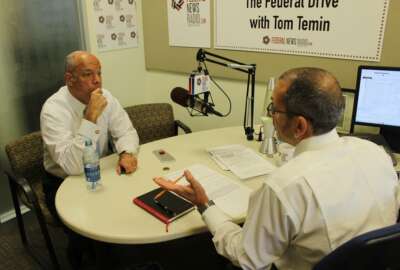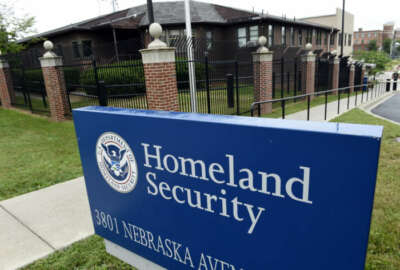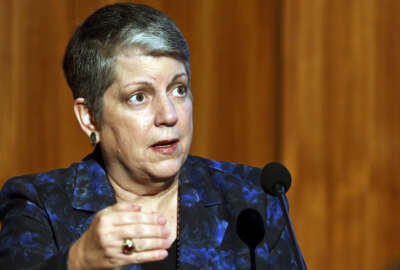
Career staff helped former DHS secretary re-imagine missions, align department
Former DHS Secretary Michael Chertoff worked with the leadership and senior career staff to turn a collection of disparate agencies from different departments into...
When Michael Chertoff took over the reins of the Homeland Security Department from Tom Ridge in 2005, it was still experiencing growing pains. Chertoff’s four-year tenure as DHS secretary was a period of fine-tuning for the department, as Chertoff worked with the leadership and senior career staff to turn a collection of disparate agencies from different departments into a single, coordinated and cohesive unit.
“I think there was a range of attitudes,” Chertoff said on DHS 15th Anniversary. “I think relatively quickly agencies, for example, like the Coast Guard, really found themselves very comfortable with the mission of the department, and actually played a very big role in bringing the department together. On the other end, [the Federal Emergency Management Agency], which had been an independent agency, resisted being part of DHS. That resistance continued during at least the first year of my tenure, until Hurricane Katrina.”
Chertoff said that Ridge had put together the basic foundation of the department, so now it was his task to develop that department’s central processing. Toward that end, he initiated a second-stage review, organizing a team of senior people at the department to review its structure and consider reorganizing.
He also put together a weekly meeting of leadership from all the various components, a kind of coordination group, not only to update him on their progress, but also so each agency could have visibility across the components and the whole department. Chertoff compared it to the Defense Department’s Joint Staff.
He also made it a point to include the senior career staff in these processes as he transitioned into the position.
“I actually relied heavily on the people who were there already, and they formed a good deal of the backbone of what we did from a staffing standpoint,” Chertoff said. “That was because I had been a civil servant myself for most of my career. I came to the job having been at the Department of Justice for about a dozen years. So I respected the work that they did, and I was familiar with that work from my period of time at Justice, so I think that we were very comfortable involving them in all the decision-making processes.”
And that helped, because bringing the various components into the fold could require deep dives into an agency’s operations. Some, like the Coast Guard, were natural fits.
“The Coast Guard provided a lot of the DNA of the department, because they’re very used to the idea of blending a military and a civilian mission together in order to achieve security,” Chertoff said.
But other agencies were more problematic.
“[The Transportation Security Administration] interacts with an awful lot of people,” he said. “What that means is you hear a lot about the good, the bad, the indifferent on a daily basis. So obviously it absorbed a fair bit of attention.”
Chertoff gave an example where, roughly a year into TSA’s existence, a hijacking was foiled, in which radicals intended to refill drink bottles with accelerants for bombs through pinholes in the bottom. Until that point, TSA had allowed sealed drink containers on planes.
“This required us to redo our entire concept of operations,” Chertoff said. “So that was an example of the way in which we got very deeply involved in the operational details of how to carry out TSA’s mission on a regular basis.”
And still, other agencies, like FEMA, underwent a total overhaul of their mission.
“The doctrine and the approach to natural disasters had always been that the first responder is the state and local government,” Chertoff said. “They have the National Guard, they have the police and fire departments. They will initially own the responsibility to evacuate people, and the government’s job is to support.”
In this scenario, FEMA provided things like military support, aircraft and medical facilities. They resolved claims after the fact. But that all changed with Hurricane Katrina.
“What happened with Katrina is that the state and local governments were unable to operate,” Chertoff said. “The mayor basically hid out in a hotel room, and the governor was not able to really operate effectively. And there was no plan in place to evacuate, even though we had said to them, ‘You had better evacuate.'”
“All of a sudden, what fell into the lap of the federal government was the job of first response,” he continued. “Catching up with that by developing a plan on the run was very difficult.”
There were some successes: The Coast Guard managed to rescue more than 30,000 people, for example. But largely, it was a situation for which DHS was ill-prepared.
“We decided we needed to change the doctrine,” Chertoff said. “And the federal government had to be in a position, if necessary, to step in and take the role of first responder.”
So when hurricanes Ike and Gustav hit in 2008, FEMA was far better prepared, working as a partner rather than a supplement to state and local governments.
“The key lesson was ‘planning, planning, planning.’ You can’t do the job if you react. You have to work in advance and anticipate,” Chertoff said.
Copyright © 2025 Federal News Network. All rights reserved. This website is not intended for users located within the European Economic Area.
Daisy Thornton is Federal News Network’s digital managing editor. In addition to her editing responsibilities, she covers federal management, workforce and technology issues. She is also the commentary editor; email her your letters to the editor and pitches for contributed bylines.
Follow @dthorntonWFED





